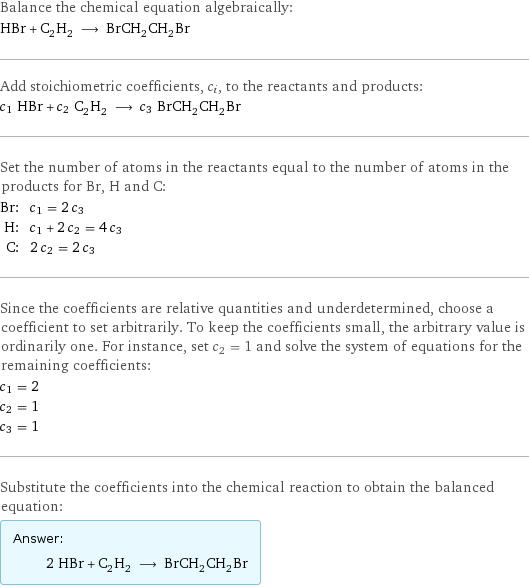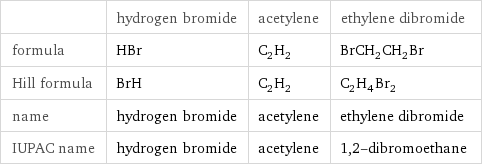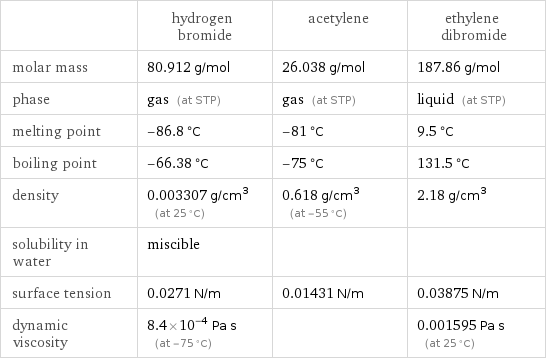Input interpretation

HBr hydrogen bromide + C_2H_2 acetylene ⟶ BrCH_2CH_2Br ethylene dibromide
Balanced equation

Balance the chemical equation algebraically: HBr + C_2H_2 ⟶ BrCH_2CH_2Br Add stoichiometric coefficients, c_i, to the reactants and products: c_1 HBr + c_2 C_2H_2 ⟶ c_3 BrCH_2CH_2Br Set the number of atoms in the reactants equal to the number of atoms in the products for Br, H and C: Br: | c_1 = 2 c_3 H: | c_1 + 2 c_2 = 4 c_3 C: | 2 c_2 = 2 c_3 Since the coefficients are relative quantities and underdetermined, choose a coefficient to set arbitrarily. To keep the coefficients small, the arbitrary value is ordinarily one. For instance, set c_2 = 1 and solve the system of equations for the remaining coefficients: c_1 = 2 c_2 = 1 c_3 = 1 Substitute the coefficients into the chemical reaction to obtain the balanced equation: Answer: | | 2 HBr + C_2H_2 ⟶ BrCH_2CH_2Br
Structures

+ ⟶
Names

hydrogen bromide + acetylene ⟶ ethylene dibromide
Equilibrium constant
![Construct the equilibrium constant, K, expression for: HBr + C_2H_2 ⟶ BrCH_2CH_2Br Plan: • Balance the chemical equation. • Determine the stoichiometric numbers. • Assemble the activity expression for each chemical species. • Use the activity expressions to build the equilibrium constant expression. Write the balanced chemical equation: 2 HBr + C_2H_2 ⟶ BrCH_2CH_2Br Assign stoichiometric numbers, ν_i, using the stoichiometric coefficients, c_i, from the balanced chemical equation in the following manner: ν_i = -c_i for reactants and ν_i = c_i for products: chemical species | c_i | ν_i HBr | 2 | -2 C_2H_2 | 1 | -1 BrCH_2CH_2Br | 1 | 1 Assemble the activity expressions accounting for the state of matter and ν_i: chemical species | c_i | ν_i | activity expression HBr | 2 | -2 | ([HBr])^(-2) C_2H_2 | 1 | -1 | ([C2H2])^(-1) BrCH_2CH_2Br | 1 | 1 | [BrCH2CH2Br] The equilibrium constant symbol in the concentration basis is: K_c Mulitply the activity expressions to arrive at the K_c expression: Answer: | | K_c = ([HBr])^(-2) ([C2H2])^(-1) [BrCH2CH2Br] = ([BrCH2CH2Br])/(([HBr])^2 [C2H2])](../image_source/afc952a63dd9ee721076c0d78d0aa5c7.png)
Construct the equilibrium constant, K, expression for: HBr + C_2H_2 ⟶ BrCH_2CH_2Br Plan: • Balance the chemical equation. • Determine the stoichiometric numbers. • Assemble the activity expression for each chemical species. • Use the activity expressions to build the equilibrium constant expression. Write the balanced chemical equation: 2 HBr + C_2H_2 ⟶ BrCH_2CH_2Br Assign stoichiometric numbers, ν_i, using the stoichiometric coefficients, c_i, from the balanced chemical equation in the following manner: ν_i = -c_i for reactants and ν_i = c_i for products: chemical species | c_i | ν_i HBr | 2 | -2 C_2H_2 | 1 | -1 BrCH_2CH_2Br | 1 | 1 Assemble the activity expressions accounting for the state of matter and ν_i: chemical species | c_i | ν_i | activity expression HBr | 2 | -2 | ([HBr])^(-2) C_2H_2 | 1 | -1 | ([C2H2])^(-1) BrCH_2CH_2Br | 1 | 1 | [BrCH2CH2Br] The equilibrium constant symbol in the concentration basis is: K_c Mulitply the activity expressions to arrive at the K_c expression: Answer: | | K_c = ([HBr])^(-2) ([C2H2])^(-1) [BrCH2CH2Br] = ([BrCH2CH2Br])/(([HBr])^2 [C2H2])
Rate of reaction
![Construct the rate of reaction expression for: HBr + C_2H_2 ⟶ BrCH_2CH_2Br Plan: • Balance the chemical equation. • Determine the stoichiometric numbers. • Assemble the rate term for each chemical species. • Write the rate of reaction expression. Write the balanced chemical equation: 2 HBr + C_2H_2 ⟶ BrCH_2CH_2Br Assign stoichiometric numbers, ν_i, using the stoichiometric coefficients, c_i, from the balanced chemical equation in the following manner: ν_i = -c_i for reactants and ν_i = c_i for products: chemical species | c_i | ν_i HBr | 2 | -2 C_2H_2 | 1 | -1 BrCH_2CH_2Br | 1 | 1 The rate term for each chemical species, B_i, is 1/ν_i(Δ[B_i])/(Δt) where [B_i] is the amount concentration and t is time: chemical species | c_i | ν_i | rate term HBr | 2 | -2 | -1/2 (Δ[HBr])/(Δt) C_2H_2 | 1 | -1 | -(Δ[C2H2])/(Δt) BrCH_2CH_2Br | 1 | 1 | (Δ[BrCH2CH2Br])/(Δt) (for infinitesimal rate of change, replace Δ with d) Set the rate terms equal to each other to arrive at the rate expression: Answer: | | rate = -1/2 (Δ[HBr])/(Δt) = -(Δ[C2H2])/(Δt) = (Δ[BrCH2CH2Br])/(Δt) (assuming constant volume and no accumulation of intermediates or side products)](../image_source/93f2f0f88ec2cf9220f76df6924c91cd.png)
Construct the rate of reaction expression for: HBr + C_2H_2 ⟶ BrCH_2CH_2Br Plan: • Balance the chemical equation. • Determine the stoichiometric numbers. • Assemble the rate term for each chemical species. • Write the rate of reaction expression. Write the balanced chemical equation: 2 HBr + C_2H_2 ⟶ BrCH_2CH_2Br Assign stoichiometric numbers, ν_i, using the stoichiometric coefficients, c_i, from the balanced chemical equation in the following manner: ν_i = -c_i for reactants and ν_i = c_i for products: chemical species | c_i | ν_i HBr | 2 | -2 C_2H_2 | 1 | -1 BrCH_2CH_2Br | 1 | 1 The rate term for each chemical species, B_i, is 1/ν_i(Δ[B_i])/(Δt) where [B_i] is the amount concentration and t is time: chemical species | c_i | ν_i | rate term HBr | 2 | -2 | -1/2 (Δ[HBr])/(Δt) C_2H_2 | 1 | -1 | -(Δ[C2H2])/(Δt) BrCH_2CH_2Br | 1 | 1 | (Δ[BrCH2CH2Br])/(Δt) (for infinitesimal rate of change, replace Δ with d) Set the rate terms equal to each other to arrive at the rate expression: Answer: | | rate = -1/2 (Δ[HBr])/(Δt) = -(Δ[C2H2])/(Δt) = (Δ[BrCH2CH2Br])/(Δt) (assuming constant volume and no accumulation of intermediates or side products)
Chemical names and formulas

| hydrogen bromide | acetylene | ethylene dibromide formula | HBr | C_2H_2 | BrCH_2CH_2Br Hill formula | BrH | C_2H_2 | C_2H_4Br_2 name | hydrogen bromide | acetylene | ethylene dibromide IUPAC name | hydrogen bromide | acetylene | 1, 2-dibromoethane
Substance properties

| hydrogen bromide | acetylene | ethylene dibromide molar mass | 80.912 g/mol | 26.038 g/mol | 187.86 g/mol phase | gas (at STP) | gas (at STP) | liquid (at STP) melting point | -86.8 °C | -81 °C | 9.5 °C boiling point | -66.38 °C | -75 °C | 131.5 °C density | 0.003307 g/cm^3 (at 25 °C) | 0.618 g/cm^3 (at -55 °C) | 2.18 g/cm^3 solubility in water | miscible | | surface tension | 0.0271 N/m | 0.01431 N/m | 0.03875 N/m dynamic viscosity | 8.4×10^-4 Pa s (at -75 °C) | | 0.001595 Pa s (at 25 °C)
Units
